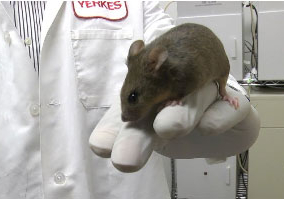Animals
Research with animals is critical to finding causes, preventions, treatments and cures for disease, and part of helping people and animals worldwide live longer, healthier lives.
At the Emory National Primate Research Center, we have 3,000 nonhuman primates and 5,000 rodents. Our Animal Resources team, which includes veterinarians, veterinary technicians and animal care, behavioral management and research services personnel, provides 24-hour care to the animals. The center follows regulations and guidelines from the National Institutes of Health, the U.S. Department of Agriculture and Emory's Institutional Animal Care and Use Committees, and supports the 3Rs in research, which are Replace animals with other models whenever possible, Reduce the number of animals used and Refine procedures to improve animal welfare. Since 1984, the Emory Primate Center (EPC) has maintained "full accreditation" from AAALAC International, a nonprofit organization that promotes humane treatment of animals in research and whose accreditation is recognized as the gold standard for laboratory animal care.
Animals at the EPC include:
Rhesus Macaque - Native to Southeast Asia
The rhesus macaque is the Emory Primate Center's (EPC) most common nonhuman primate and the most commonly used monkey in biomedical research. Rhesus macaques make valuable contributions to EPC infectious disease research, including AIDS vaccine, immunology and treatment research as well as emerging infectious diseases, including Zika virus and COVID-19, and research programs involving aging, neurodegenerative diseases, including Parkinson's disease, reproductive biology, maternal care, biological basis of social behavior and organ transplantation.

Sooty Mangabey - Native to West Africa
The sooty mangabey is the source of HIV-2, a less-virulent strain of HIV. EPC researchers are studying these animals in efforts to refine and develop new treatments for AIDS and HIV infection. In addition, sooty mangabeys contribute to research involving reproductive biology and behavior, social system dynamics, immune function and evolution of growth.

Rodents
The center's vivarium is home to 5,000 rodents, including mice, rats and voles, which are often the first animal models used in research programs. Rodents are involved in a number of studies, including those on addiction, autism spectrum disorders, behavioral neuroscience, stroke, neurodegenerative diseases, including Parkinson's disease, brain imaging, TB and emerging infectious diseases, including Zika virus and COVID-19.

Behavioral Management and Animal Welfare
One element of the EPC's extensive Animal Care program is Behavioral Management which applies science-based care to provide for the psychological well-being of our center's nonhuman primates (NHPs). We promote, maintain and measure NHP well-being, promote species-appropriate and natural behaviors, and treat and even prevent behavioral problems. To do this, we implement a program that includes socialization opportunities, environmental enrichment and training. This combination ensures program effectiveness, makes best use of center resources and helps EPC personnel regularly incorporate recent developments in animal welfare science.